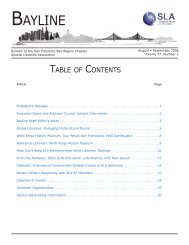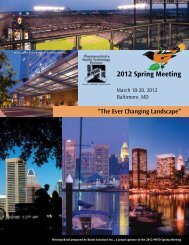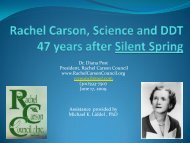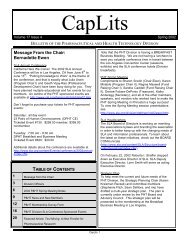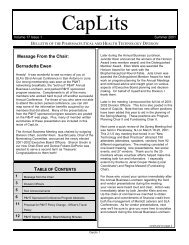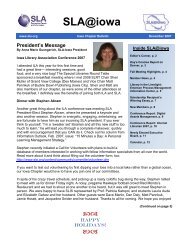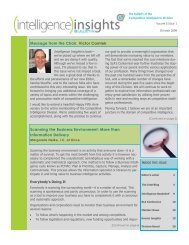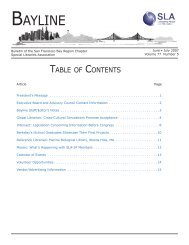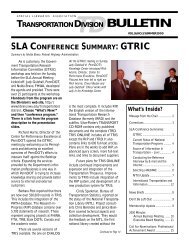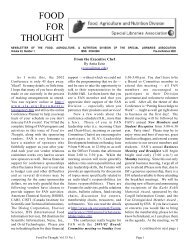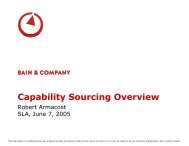ERMD NEWS - units.sla.org - Special Libraries Association
ERMD NEWS - units.sla.org - Special Libraries Association
ERMD NEWS - units.sla.org - Special Libraries Association
Create successful ePaper yourself
Turn your PDF publications into a flip-book with our unique Google optimized e-Paper software.
<strong>ERMD</strong> <strong>NEWS</strong><br />
Newsletter of the Environment and Resource Management Division, <strong>Special</strong> <strong>Libraries</strong> <strong>Association</strong><br />
Volume 13 Number 3 Winter 2007 www.<strong>sla</strong>.<strong>org</strong>/division/derm/<br />
CONTENTS<br />
Message from the Chair. . . . . . . . . 1<br />
Editor’s Note. . . . . . . . . . . . . . . . . 2<br />
Re<strong>org</strong>anization of Forestry<br />
Service <strong>Libraries</strong> . . . . . . . . . . . . . . 3<br />
The Hook of IFQs . . . . . . . . . . . . . . 4<br />
Shark Released in California. . . . . . . 5<br />
Ocean Conservation Web Sites . . . . 6<br />
More Agency Updates . . . . . . . . . . . 7<br />
--Notice Regarding Listing<br />
of Polar Bears as Threatened<br />
--CRS Report on EPA Library<br />
Restructuring<br />
Book Review: The Empty Ocean,<br />
by Richard Ellis . . . . . . . . . . . . . . .8<br />
Film Reviews . . . . . . . . . . . . . . . . . 8<br />
La Jolla Harbor Seal Colony . . . . . .11<br />
NMFS Incidental Taking Notices<br />
under the MMPA . . . . . . . . . . . . .12<br />
Library Profile: NOAA Central<br />
Library . . . . . . . . . . . . . . . . . . . .13<br />
NOAA-Louisiana Publication Available<br />
Regarding Oil Spill Protection. . . . 15<br />
2006-2007 Officers . . . . . . . . . . . .16<br />
Photographer: A. Hubert, from NOAA Photo Library<br />
at www.photolib.noaa.gov/nurp/nur00011.htm<br />
. See story on page 13 about other resources<br />
available from the NOAA Central Library.<br />
Message from the Chair<br />
by Barbara Holder<br />
Thank you for the opportunity<br />
to serve as Division Chair for<br />
2007. I will try my best to make<br />
a difference around here! I am<br />
proud to lead one of SLA’s most<br />
topical and welcoming Divisions.<br />
My journey began when I<br />
joined Forintek Canada and was<br />
cajoled by my (then) boss and<br />
(subsequent) mentor to join her<br />
assiduous networking activities.<br />
Knowing the right people was key she told me. I began<br />
to attend local SLA meetings, expanded my network and<br />
gained many useful skills and contacts working on different<br />
projects over the years.<br />
In 1990 the boss retired and I was able to attend my<br />
first annual conference. I naturally gravitated to our<br />
division, home to forestry types, amongst others. My first<br />
experience at public speaking came via an invitation to<br />
speak at the Forestry Roundtable of <strong>ERMD</strong>. I had to take a<br />
public speaking course to be able to face the challenge. (It<br />
has since become easier!)<br />
My stint as chair of the SLA Western Canada Chapter<br />
taught me the value of TEAM work (Together Everyone<br />
Achieves More). With that in mind, I would like to thank<br />
the retiring and continuing Board members for their<br />
sterling work, and welcome the new Board members,<br />
acclaimed in the Division’s first electronic election held in<br />
December. The new Board members are:<br />
Cynthia Bennington - Chair-Elect<br />
Continued on page 3
Editor’s Note<br />
Contributors to this<br />
issue:<br />
Cynthia Bennington<br />
Julie Blankenburg<br />
Stanley Elswick<br />
Barb Holder<br />
Frederic Murray<br />
Bobbi Weaver<br />
<strong>ERMD</strong> News ~ Winter 2007<br />
by Bobbi Weaver<br />
With much trepidation, I’ve attempted to figure out the<br />
newsletter software. The learning process is ongoing, so<br />
please be patient with me. I enrolled in a community<br />
college course on the software package, but I have to share<br />
the instructor’s time with about 80 other students.<br />
This issue focuses on ocean conservation. Being a resident<br />
of a coastal community, San Diego, this issue is near and<br />
dear to me. I’m especially interested in the preservation of<br />
marine wildlife habitats, and I have been active in an effort<br />
to preserve a harbor seal colony in the San Diego area. I’ve<br />
included a brief article about the research used to support<br />
this effort in this issue.<br />
The featured library is the NOAA Central Library in Silver<br />
Spring, MD. The article highlights the library’s role in ocean<br />
conservation. There is also an excellent article on individual<br />
fishing quotas (IFQs) by Frederic Murray of Southwestern<br />
Oklahoma State University.<br />
I hope you find this issue informative. I’d like to give special<br />
thanks to those members who helped with this issue.<br />
Next Issue’s Theme: Forestry Conservation<br />
and Resources<br />
Copy Deadline: April 1, 2007<br />
<strong>ERMD</strong> <strong>NEWS</strong><br />
the Quarterly Newsletter of the<br />
Environment and Resource Management<br />
Division of the <strong>Special</strong> <strong>Libraries</strong> <strong>Association</strong><br />
Editor<br />
Bobbi Weaver, M.L.I.S.<br />
Tel 619-525-1497<br />
baw@cwsl.edu<br />
<strong>ERMD</strong> <strong>NEWS</strong><br />
is published electronically in pdf format four<br />
times per year by the Environment and Resource<br />
Management Division of SLA. It is available to<br />
division members as a membership benefit.<br />
Communications regarding the contents of this<br />
issue should be sent to the editor via the email<br />
address given above or to the author’s email<br />
address if given.<br />
Advertising:<br />
Rate Schedule:<br />
Full Page $250<br />
Half Page Horizontal $130<br />
Quarter Page $65<br />
Business Card $35<br />
Discount for Prepaid Ad – 3 + issues 10%<br />
Discount for Prepaid Ad – 2 issues 5%<br />
To place an advertisement, contact Gabe McAuliffe,<br />
<strong>ERMD</strong> advertising manager, at tel 916-444-<br />
6666 or email gmcauliffe@sierraresearch.com.<br />
Acceptance of an advertisement does not imply<br />
the endorsement of the product by <strong>ERMD</strong> or the<br />
<strong>Special</strong> <strong>Libraries</strong> <strong>Association</strong>.<br />
Copy Deadlines:<br />
July 1—Summer Issue<br />
October 1—Fall Issue<br />
January 10—Winter Issue<br />
April 1—Spring Issue<br />
The <strong>Special</strong> <strong>Libraries</strong> <strong>Association</strong> assumes no<br />
responsibility for the statements and opinions<br />
advanced by the contributors to the association’s<br />
publications. Editorial views do not necessarily<br />
represent the official position of the <strong>Special</strong><br />
<strong>Libraries</strong> <strong>Association</strong>.<br />
ISSN 1553-1422<br />
2
Message from the Chair, cont.<br />
Shelley Arvin - Secretary (2007-2008)<br />
Jan Hutchins – Director (2007-2008)<br />
The new year also brings a rotation in the Division Advisory Chairs. We have several vacancies.<br />
If any of these opportunities appeal to you personally or would suit someone in your circle of<br />
influence, let me know. The retiring chairs will act as a resource for the incoming chairs. The<br />
currently open positions are:<br />
Archivist<br />
Discussion list – SLA members only<br />
Membership Committee<br />
Nominating Committee<br />
Toxicology Roundtable<br />
Web Committee.<br />
The program for Denver is set with interesting and relevant topics – we are still gathering<br />
sponsorships. Cynthia and I will be attending the Leadership Summit in Reno in January to start<br />
the planning process for Seattle 2008. We hope to see you all there!<br />
Agency Update<br />
REORGANIZATION OF THE U.S. FORESTRY SERVICES LIBRARIES<br />
By Julie Blankenburg<br />
The U.S. Forest Service re<strong>org</strong>anized its’ library services as of Oct. 1, 2006. Five regional libraries merged<br />
administratively to become the National Forest Service Library.<br />
The service area for library services changed from a regional/local focus to a national focus. This resulted in an<br />
approximately 40% increase in the customer base for library services.<br />
Library services are being brought online nationally throughout the coming year. Our current awareness service is<br />
up and running and a table-of-contents service will be next. We are very excited about the current changes and<br />
improved service levels we will be able to provide to our agency.<br />
For more information please contact Carol Ayer (cayer@fs.fed.us) or Julie Blankenburg (jblankenburg@fs.fed.us)<br />
<strong>ERMD</strong> News ~ Winter 2007<br />
3
The Hook of IFQs: Fisheries Management One Share at a Time<br />
By Frederic Murray<br />
According to Mark Kurlansky, best-selling author of Cod: A Biography of the Fish that Changed the<br />
World, at one point in the Middle Ages diminishing herring stocks were blamed on the adulterous ways<br />
of fishing villages. If there were less sin, there would be more fish. Fortunately, rather than examining the<br />
sexual mores of today’s modern fishing fleets, a group of ecologists led by Dr. Boris Worm of Dalhousie<br />
University, Halifax, Nova Scotia, has focused on questions of oceanic biodiversity and the impact of<br />
human-dominated marine ecosystems. These ecologists are reporting that loss of biodiversity in the ocean<br />
populations is directly related to the diminishing catches of wild fish. So dire is their report, Impacts<br />
of Biodiversity Loss on Ocean Ecosystem Services (SCIENCE VOL 314 3Nov2006) that they have<br />
projected a collapse of all commercial fish and seafood species by 2048.<br />
The need for sustainable management of fishing has never been greater. Poor resource management,<br />
combined with an unfettered belief in the “freedom of the seas”, has led to the near collapse of commercial<br />
fisheries on a global scale. It has been noted by Garrett Harden that the metaphor of the Tragedy of the<br />
Commons has found expression in the collapse of fisheries because people have interpreted the “freedom<br />
of the seas” to include an unlimited right to fish them. The fish are, in effect, a commons and traditional<br />
methods of management, including, but not limited to nations exerting and extending sovereignty from<br />
three miles off-shore to two hundred miles has done nothing to eliminate the problem of the commons: If<br />
all have access to a common resource, none have long term interest in sustaining it. Or as Kurt Vonnegut<br />
wrote in his novel Hocus Pocus: “(a major) flaw in the human character is that everybody wants to build<br />
and nobody wants to do maintenance.”<br />
Today’s management plans for ocean fisheries seem part and parcel of extraction economies that have<br />
no place in our growing understanding of the complexity of living ecosystems. Mined out and played out<br />
should no longer be acceptable phrases in the management of any natural resource, be it coal, timber<br />
or fish. The common method of fisheries management has been to estimate the maximum “sustainable”<br />
yield and then fix fishing to either a certain number of days or some kind of aggregate catch. What this<br />
has lead to are Derby Days of frenzied competition with an overinvestment in material, and levels of<br />
bycatch (species other than those targeted) reaching unacceptable numbers. The results: waste, loss and,<br />
according to Dr. Worm, a measurable impact on oceanic biodiversity.<br />
A share-based management system called Individual Fishing Quotas (IFQs) has been gaining ground<br />
in the attempts to reform the practice of fisheries management. IFQ programs are a type of access<br />
program which provide fisherman or corporations exclusive rights to harvest a fixed percentage of the<br />
total allowable catch of a fishery through the allocation or purchase of shares. The program grants the<br />
fisherman greater flexibility in their fishing activities (no longer limiting them to certain days, which given<br />
the caprice of ocean storms is no small matter) as well as the right to sell their fishing shares in the<br />
marketplace. EBay on the High Seas. IFQs are seen as a way of reducing bycatch, because IFQ holders are<br />
not racing against the clock and therefore can be more selective in their methods of targeting fish. Under<br />
the Magnuson-Stevens Fishery Conservation and Management Act (1996) there were three IFQ systems in<br />
the United States: the North Pacific halibut; the South Atlantic wreckfish fishery, and the Mid-Atlantic surf<br />
clam. In January 2007, the Gulf fisheries Red Snapper IFQ will come into place. This kind of market based<br />
management program has been successfully practiced in New Zealand, Australia, Scotland, Iceland and<br />
Let us know of your comings & goings,<br />
awards, promotions, publications.<br />
We’ll include your news in the next issue of<br />
<strong>ERMD</strong> News.<br />
baw@cwsl.edu
Canada. Recognition has been granted that IFQ programs are a better management tool than simple quota<br />
systems in that underperforming fisherman (and who hasn’t had a bad day on the water) have a greater<br />
opportunity at compensation through selling their shares if unable to fill their allowable catch. It is a given<br />
that most people, and certainly industries, will exercise greater care if they have a vested stake in what<br />
they own instead of viewing natural resources as common ground open to an unlimited raid.<br />
In 2006 Pacific Northwest maritime regulations <strong>sla</strong>shed the allowable commercial catch of Chinook and<br />
Coho salmon by 60% because of the lack of mature fish returning to spawn in the rivers. The remaining<br />
40% of the allowable catch faced double the pressure because reducing the catch did not reduce the<br />
number of fisherman competing for a smaller and smaller piece of the pie. Those that are unsuccessful<br />
have no way to recoup their loss other than to sell their boats and abandon a way of life. Those that<br />
are successful are often so because their incentive is not to manage the fish, but merely catch them. A<br />
sustainable management of fisheries is possible, and if fish are a publicly owned resource we would should<br />
heed the new practice of structuring already existing harvesting systems into new the models offered by<br />
IFQs.<br />
It’s that, or we could return to blaming the village gossip.<br />
For more information visit the National Marine Fisheries Service at: www.nmfs.noaa.gov.<br />
Great White Shark Released from Captivity in California<br />
By Bobbi Weaver<br />
This month, a great white shark, held in captivity at the Monterey Aquarium since September, was released<br />
into the ocean. The shark, fitted with an electronic device to transmit information to researchers, appeared<br />
healthy as it swam into Monterey Bay.<br />
The young male shark was captured in Santa Monica Bay in mid-August 2006. It was temporarily housed<br />
in an ocean pen in Southern California, and then transported to the Monterey Aquarium. While in captivity,<br />
the shark grew 9 inches in length and added 68 pounds. During the shark’s first weekend at the aquarium,<br />
approximately 17,000 people visited the aquarium, generating about $200,000 that the aquarium can<br />
use for further research. The shark was not aggressive towards other fish in his tank, but aquarium<br />
researchers determined that the time was appropriate to release the animal into the wild.<br />
The Monterey Aquarium has exhibited the most success in keeping great white sharks in captivity. In<br />
other aquariums, the sharks have not lived past 16 days. The Monterey Aquarium housed another female<br />
great white shark for 198 days from late 2004 to early 2005. The female shark’s behavior was becoming<br />
aggressive and she did kill other sharks in her tank. The aquarium released the female shark into the wild<br />
on March 31, 2005.<br />
Although sharks in captivity have provided valuable information to researchers and information on<br />
conservation to aquarium visitors, not all conservationists advocate keeping the animals in captivity. Some<br />
scientists and animal advocates have asserted that high likelihood of death in captivity as well as the<br />
danger posed to other animals in the same living area provide valid arguments against the captivity of<br />
great white sharks.<br />
Information on the Monterey Aquarium’s research on great white sharks is available online at<br />
www.mbayaq.<strong>org</strong>/cr/whiteshark.asp. For a different perspective, look at the web site of the Pelagic Shark<br />
Research Foundation at www.pelagic.<strong>org</strong>/.<br />
<strong>ERMD</strong> News ~ Winter 2007<br />
5
Brief Webography of Ocean<br />
Conservation Internet Sites<br />
By Bobbi Weaver<br />
The Internet provides an excellent tool for educating<br />
the public on issues regarding ocean conservation.<br />
It provides a means for nonprofit <strong>org</strong>anizations,<br />
government groups, and educational institutions to<br />
disseminate this pertinent information. The following<br />
article highlights just a few of the resources available<br />
online on conserving our seas.<br />
GOVERNMENT ENTITIES<br />
National Oceanic and Atmospheric<br />
Administration—www.noaa.gov/<br />
--NOAA’s web site includes links to a wealth of<br />
information, including a link to the NOAACentral<br />
Library’s web page.<br />
National Marine Fisheries Service—<br />
www.nmfs.noaa.gov/<br />
--A division of NOAA, this agency is charged with the<br />
protection of the U.S.A’s marine resources.<br />
USGS Science Center for Coastal and Marine<br />
Geology—woodshole.er.usgs.gov/<br />
--Located in Woods Hole, Massachusetts, this federal<br />
<strong>org</strong>anization is responsible for research concerning<br />
the USGS Coastal and Marine Geology Program. Its<br />
web site provides links to some of the Program’s<br />
recent publications.<br />
UN Division for Ocean Affairs and the Law of<br />
the Sea—www.un.<strong>org</strong>/Depts/los/index.htm<br />
--This part of the United Nations provides a link to<br />
the United Nations Convention on the Law of the Sea<br />
(UNCLOS) and related agreements. It also provides<br />
other links relevant to the Division’s work.<br />
EDUCATIONAL GROUPS<br />
Consortium for Oceanographic Research and<br />
Education—www.coreocean.<strong>org</strong>/<br />
--This group’s web site provides links to a variety of<br />
reports on ocean research.<br />
Center for Oceans Law and Policy—<br />
www.virginia.edu/colp/<br />
--Part of the University of Virginia, the Center’s web<br />
site provides links to information on its publications<br />
and conferences.<br />
<strong>ERMD</strong> News ~ Winter 2007<br />
Gerald J. Mangone Center for Marine Policy—<br />
www.ocean.udel.edu/cmp/<br />
--This Center is part of the University of Delaware.<br />
Its web site provides links to<br />
recent publications and reports on research<br />
Marine & Environmental Law Institute—<br />
www.dal.ca/law/melaw<br />
--Part of Dalhousie Law School in Nova Scotia, the<br />
Institute’s web site provides links to information on<br />
its publications and research.<br />
NONPROFIT ORGANIZATIONS<br />
The Ocean Conservancy—www.oceanconservan<br />
cy.<strong>org</strong><br />
--This <strong>org</strong>anization provides links to articles on<br />
various issues regarding ocean conservation. The<br />
link to “Fish & Wildlife” provides further links to<br />
articles on various threatened species of ocean life.<br />
The Ocean Foundation—www.oceanfdn.<strong>org</strong>/<br />
--The Ocean Foundation provides financial and<br />
educational support to other <strong>org</strong>anizations<br />
concerned with protecting our oceans. The web<br />
site includes links to its newsletters and relevant<br />
reports.<br />
The Ocean Alliance—www.oceanalliance.<strong>org</strong>/<br />
--The Ocean Alliance promotes education on the<br />
conservation of the ocean’s resources. Its web<br />
site includes links to the group’s research and<br />
educational efforts.<br />
Sea Shepard Conservation Society—<br />
www.seashepherd.<strong>org</strong>/<br />
--Sea Shepard focuses on the protection of marine<br />
mammals. Its web site has links to recent news<br />
articles, current campaigns, and merchandise<br />
available for sale to support the <strong>org</strong>anization and<br />
its efforts.<br />
SeaWeb—www.seaweb.<strong>org</strong>/home.php<br />
--SeaWeb uses scientific education to promote the<br />
sustainable use of the ocean’s resources.<br />
The Marine Mammal Center—www.tmmc.<strong>org</strong>/<br />
--This <strong>org</strong>anization rescues and rehabilitates<br />
marine mammals, provides education to the public<br />
on marine mammals, and promotes protection of<br />
marine mammals.<br />
6
International Marine Mammal Project—www.earthi<strong>sla</strong>nd.<strong>org</strong>/IMMP/<br />
--This group focuses on the protection of whale and dolphin species.<br />
World Wildlife Fund, “Our Solutions: Sustainable Fishing”—www.panda.<strong>org</strong>/about_wwf/what_we_<br />
do/marine/our_solutions/sustainable_fishing/index.cfm<br />
--This section of WWF’s global web site provides information on the sustainable use of the ocean’s<br />
resources.<br />
Environmental Defense Network, Oceans Alive—www.oceansalive.<strong>org</strong>/eat.cfm<br />
--This web site provides information on the types of fish to eat to promote sustainable fishing. It includes<br />
a printable “Pocket Seafood Selector” to use while shopping or dining at restaurants serving seafood.<br />
More Agency Updates<br />
FWS Publishes Proposed Rule to List Polar<br />
Bears as Threatened<br />
By Bobbi Weaver<br />
The U.S. Fish & Wildlife’s proposed listing of the<br />
polar bear as threatened under the Endangered<br />
Species Act was published in the form of a proposed<br />
rule in the Jan. 9, 2007 Federal Register. Public<br />
comments on the following issues are being<br />
solicited by the agency:<br />
--Information on the animal’s taxonomy,<br />
distribution, habitat selection, food habits,<br />
population density and trends, habitat trends, and<br />
effects of management;<br />
--Long and short term effects of sea ice change on<br />
the distribution and abundance of polar bears and<br />
their principal prey;<br />
--Long and short term effects of other factors<br />
such as oil and gas development, contaminants,<br />
ecotourism, hunting, and poaching on the distribution<br />
and abundance of the species and their<br />
principal prey;<br />
--Regulatory and management mechanisms that<br />
might benefit the polar bears;<br />
--Information relevant to the critical habitat designation<br />
as provided by section 4 of the Endangered<br />
Species Act;<br />
--Information relevant to whether any populations<br />
of the species may qualify as distinct population<br />
segments; and<br />
--Information regarding the studies referenced in<br />
the proposed rulemaking.<br />
Comments will be accepted until April 9, 2007, and<br />
may be submitted in person, by mail, or by email<br />
to: Supervisor, U.S.Fish and Wildlife Service, Marine<br />
<strong>ERMD</strong> News ~ Winter 2007<br />
Mammals Management Office, 1011 East Tudor<br />
Road, Anchorage, Alaska 99503, email:<br />
Polar_Bear_Finding@fws.gov<br />
The proposed rule stems from a petition filed by<br />
the Center for Biological Diversity requesting that<br />
the polar bear be listed as threatened under the<br />
Endangered Species Act. Conservationists have<br />
asserted that Arctic ice—the area where polar bears<br />
live and hunt—has been depleted due to global<br />
warming.<br />
For further information, see the rule-making<br />
publication at 72 Fed. Reg. 1063-1099<br />
(Jan. 9, 2007). It is also available online at<br />
www.gpoaccess.gov. [Select the “Federal Register”<br />
link.]<br />
CRS Issues Report on EPA <strong>Libraries</strong> Restructure<br />
By Bobbi Weaver<br />
The Congressional Research Service has recently<br />
issued a report for Congress on the restructuring of the<br />
EPA Library System. The report, titled “Restructuring<br />
EPA’s <strong>Libraries</strong>: Background and Issues for Congress”<br />
is available online at www.fas.<strong>org</strong>/sgp/crs/secrecy/<br />
RS22533.pdf.<br />
The report includes a useful table of the status of the<br />
various libraries in the EPA system. It also includes<br />
a table on the funding for the libraries from 2002 to<br />
the current requested funding for FY2007. The report<br />
also touches on the increased use of the Internet for<br />
accessing EPA information, and the agency’s plans for<br />
future digitization.<br />
7
Book Review<br />
Ellis, Richard. The Empty Ocean: Plundering<br />
the World’s Marine Life. Washington: I<strong>sla</strong>nd<br />
Press, 2003. [ISBN: 1559636378; List Price:<br />
$22.50.]<br />
Reviewed by Bobbi Weaver<br />
Richard Ellis presents an excellent exposé of man’s<br />
threat to marine biodiversity in this book. He begins<br />
with a tale of the gray whales that used to swim in<br />
the Atlantic Ocean off the coast of Greenland and<br />
Iceland. Although this species is still alive in other<br />
areas, human whale-hunters exterminated the<br />
animal from the Atlantic region.<br />
The news doesn’t get much better as the book<br />
continues. Ellis describes the depletion of the<br />
world’s fish stock through overfishing and by-catch<br />
of unwanted species. He describes the incidental<br />
casualties of marine birds lured by fishermen’s bait<br />
and drowned as a result. He describes the problem<br />
of sea turtles becoming bycatch in shrimping trawls.<br />
Although this problem has been mitigated by<br />
legi<strong>sla</strong>tion, it still continues to some extent.<br />
Ellis continues with man’s attack on seal and sea<br />
lion species. Historically, the main impetus for sealhunting<br />
was for fur or oil. Early explorers sailed the<br />
world’s oceans in search of more seals to <strong>sla</strong>ughter.<br />
The <strong>sla</strong>ughter resulted in the depletion of several<br />
species of seals and sea lions, and the eradication<br />
of the Caribbean monk seal. Although seal hunting<br />
has ended in many countries, some still continues<br />
today. Most notable is the annual harp seal<br />
<strong>sla</strong>ughter in Atlantic Canada, which is still permitted<br />
by the Canadian Government despite protests from<br />
around the world.<br />
The final chapters include a chapter on whaling and<br />
the destruction of coral reefs. In this chapter, Ellis<br />
discusses the history of whaling. Some whaling<br />
by indigenous populations is still permitted today.<br />
While at one time many countries participated in<br />
this atrocity, today only a few still engage in this<br />
<strong>sla</strong>ughter. According to the author at the time of<br />
the book’s publication, Japan, Norway and Iceland<br />
continue the practice of whaling in the present day.<br />
<strong>ERMD</strong> News ~ Winter 2007<br />
Ellis describes some of the threats to coral reefs.<br />
He cites the problem of coral bleaching, which<br />
results from a rise in ocean temperatures. Some<br />
theorize that this rise in temperature may be linked<br />
to global warming. With regard to the coral in the<br />
Great Barrier Reef in Australia, Ellis describes the<br />
invasion of the Crown-of-Thorns starfish, which has<br />
depleted the coral reefs in that area. Some studies<br />
have linked agricultural runoff to this problem.<br />
Nutrients from the runoff feed algae, which is a<br />
major food source for the starfish.<br />
Ellis’ book serves as a wake-up call for ocean<br />
conservation. His sometimes shocking descriptions<br />
of man’s attack on nature would incite most<br />
reasonable people to do something, if only change<br />
one’s culinary habits to be more sustainable. The<br />
language is understandable yet comprehensive, and<br />
the text is supplemented with Ellis’ illustrations of<br />
the various species discussed. The book is suitable<br />
for a wide audience, including public and college<br />
libraries.<br />
Film Reviews<br />
Bridging the Ocean Divide (2005). Run time:<br />
22 min.[DVD available for rental or purchase from<br />
Green Planet Films at http://www.greenplanetfilms.<br />
<strong>org</strong>/ ]<br />
Reviewed by Bobbi Weaver<br />
This short film addresses the relationship between<br />
the U.S. and Japan with an emphasis on the role of<br />
the ocean for both cultures. The film begins with<br />
a narrative on the history of the U.S. and Japanese<br />
whaling industries in the late 1800s. At that time,<br />
the U.S. sent ships to Japan for whaling. The<br />
Japanese engaged in whaling as well. The U.S.<br />
and Japanese whalers often interacted, sharing<br />
technologies and other aspects of each others’<br />
cultures.<br />
The second part of the film focuses on the modern<br />
day, with a narrative from U.S. dolphin researcher,<br />
Dr. Kathleen Dudzinski. Dr. Dudzinski has studied<br />
bottle-nosed dolphins near the i<strong>sla</strong>nd of Mikura<br />
in Japan. She spends a great deal of time doing<br />
educational outreach to the school children of<br />
the i<strong>sla</strong>nd. Dr. Dudzinski states that the children<br />
8
have a great deal of pride in their i<strong>sla</strong>nd heritage,<br />
and respect for the area’s natural history. She<br />
discussed a 2004 cultural exchange program<br />
involving students from the United States. The film<br />
concludes with excerpts of interviews with these<br />
U.S. exchange students on their perceptions of the<br />
importance of ocean conservation.<br />
The film includes beautiful footage of the natural<br />
aspects of the i<strong>sla</strong>nd. There is also excellent<br />
underwater footage of the dolphins.<br />
Crown-of-Thorns Starfish: The Monster from<br />
the Shallows (2005). Run time: 48 min. [DVD<br />
available for rental or purchase from Green Planet<br />
Films at www.greenplanetfilms.<strong>org</strong>/ ]<br />
Reviewed by Bobbi Weaver<br />
This film documents the massive outbreak of<br />
the Crown-of-Thorns starfish in the Great Barrier<br />
Reef in Northeastern Australia, and the species’<br />
devastating effect on coral in the region. This<br />
film explores whether this out-break is a naturallyoccurring<br />
phenomena, or whether human<br />
intervention has had an effect.<br />
Detailed underwater footage of the Great Barrier<br />
Reef adds greatly to this documentary. The area<br />
extends 1500 miles along the coast of Queen<strong>sla</strong>nd<br />
and is visible from space. The Great Barrier Reef<br />
is actually comprised of 2900 smaller reefs. Its<br />
foundation is made up of coral skeletons. The top<br />
layers are made of about 400 species of hard coral<br />
and another 400 species of soft coral.<br />
The Crown-of-Thorns starfish is usually about the<br />
size of a dinner plate. It can have 7 to 21 arms,<br />
which are covered with spiny offshoots that can<br />
deliver a painful sting. On its underside, there are<br />
hundreds of tubular feet, which it uses to literally<br />
suck the life from the coral upon which it feeds.<br />
The starfish dissolves the coral polyps with its<br />
digestive juices, leaving a white scar behind.<br />
This destructive species was virtually invisible on<br />
the Great Barrier Reef until the 1960s. In 1964,<br />
15,000 Crown-of-Thorn starfish were removed from<br />
an area of the Reef around Green I<strong>sla</strong>nd. At first,<br />
scientists theorized that over-harvesting and overfishing<br />
of the starfish’s natural predators caused<br />
the tremendous outbreak of this starfish species.<br />
More recently, scientists have asserted a link of the<br />
<strong>ERMD</strong> News ~ Winter 2007<br />
Crown-of-Thorns starfish outbreak to an abundance<br />
of nutrients in the ocean due to agricultural runoff.<br />
Northern Queen<strong>sla</strong>nd produces a large amount<br />
of sugar cane and raises cattle. Runoff from the<br />
cattle pastures and sugar cane fields results from<br />
rain that washes nutrients from the land to the sea.<br />
The nutrients produce algae, a primary food for the<br />
Crown-of-Thorns starfish. Hence, the species has<br />
been thriving uncontrolled.<br />
The film’s narrator indicates that over-fishing may<br />
still be a factor, as many of the species that preyed<br />
upon the Crown-of-Thorns starfish have been<br />
removed from the Reef by human overexploitation.<br />
Human divers now regularly inject the starfish with<br />
toxins to kill them in an effort to control outbreaks<br />
and conserve the coral reefs.<br />
The film was quite informative, and the underwater<br />
cinematography was excellent. The narration is<br />
quite explanatory and understandable to laypeople.<br />
The film does an excellent job of explaining this<br />
environmental crisis, and possible solutions for coral<br />
reef conservation.<br />
The Baltic: Sea of Surprises (2004). Run Time:<br />
40 min.[DVD available for purchase at $1.80 from<br />
Green Planet Films at http://www.greenplanetfilms.<br />
<strong>org</strong>/ ]<br />
Reviewed by Bobbi Weaver<br />
This film from Finland is made up of four 10minute<br />
segments on various aspects of the Baltic<br />
Sea. Part I is titled “Sea of Ice” and documents the<br />
environment of the Baltic Sea when frozen in the<br />
winter. There is underwater footage to show the<br />
vibrant freshwater and salt water life under the ice.<br />
Grey seals use the icy patches to give birth, and use<br />
ice holes to gain access to the water to fish. This<br />
part of the film ends with comments on the effects<br />
of pollution in the area.<br />
In Part II, “A Fragile Sea,” the filmmakers elaborate<br />
on the problems of pollution and its effects on the<br />
marine wildlife. The narrator tells of seals and<br />
birds in the area suffering from a variety of health<br />
problems. Both the seals and the birds obtain their<br />
food from the sea. Marine pollution from human<br />
sources deposits toxins in the sea which effect the<br />
fish living there. Fish for human consumption from<br />
the Baltic also contain some toxins.<br />
Part III, titled “Voyagers,” it begins with a discussion<br />
9
of sand gapers, a non-indigenous species brought<br />
from North America by the Vikings. This shellfish<br />
species escaped into the Baltic. They attach to the<br />
hulls of ships and removal is laborious. A special<br />
paint has been used on the ships to dissuade<br />
attachment of the shellfish. Unfortunately, the paint<br />
is toxic and the toxins have seeped into the water<br />
of the Baltic. This part continues with a discussion<br />
on the impact of human activity on the marine<br />
wildlife. The problem of porpoises being tangled<br />
in fishing nets and perishing is addressed. The<br />
narrator discusses the use by Danish fishermen of<br />
high-frequency devices to deter the porpoises from<br />
entering the fishing nets. The narrator continues by<br />
discussing the impact of over-fishing on the fishery<br />
stock of the Baltic.<br />
The final part titled “Sensitive Shores” focuses on<br />
the land bordering the Baltic Sea. The narrator<br />
starts with a discussion on the historical background<br />
of the area, and the early settler’s use of the natural<br />
resources. Information on the birds that nest on<br />
the land is described. The narrator notes that<br />
many birds in the region fly north to the Arctic in<br />
the spring to breed, and this event is observed by<br />
many birdwatchers in the region. With increased<br />
human interaction in the area, however, comes<br />
some disruption of the ecosystem. More people<br />
are vacationing in the area, and the noise from<br />
motor boats and other human activity disturbs some<br />
wildlife species. The narrator also comments on the<br />
contamination from deliberate oil discharges from<br />
boats in the Baltic, and the impact on the marine<br />
wildlife in the region.<br />
This film includes excellent wildlife and underwater<br />
footage. It is quite informative, especially for those<br />
who do not have a lot of familiarity with the region.<br />
The price is right, and I would recommend it for<br />
both public and research library collections.<br />
Ocean Odyssey (BBC, 2006)<br />
Reviewed by Bobbi Weaver<br />
This documentary has a sad beginning. It opens<br />
with a stranded and dying sperm whale beached<br />
in New Zealand. The rest of the film attempts to<br />
tell the ocean’s story through the eyes of this great<br />
animal. The film shows a mother sperm whale<br />
with her calf, traveling the depths of the ocean.<br />
The narrator explains that sperm whales use an<br />
<strong>ERMD</strong> News ~ Winter 2007<br />
echolocation system to navigate the ocean and hunt<br />
for prey. Sperm whales are they key predator in<br />
the world’s largest food chain, and an adult sperm<br />
whale can consume 500 squid in a single hunting<br />
dive. The narrator explains that sperm whales<br />
actually suck in their prey and crush it with the<br />
muscles in their stomachs.<br />
However, even predators can sometimes become<br />
potential prey for other animals. The giant squid is<br />
the size of a family car, yet it is one of the favorite<br />
types of prey for the sperm whale, despite its<br />
grand size. Battles between sperm whales and<br />
giant squid can sometimes be fatal for the whale,<br />
especially if it is younger and smaller in size. Also,<br />
orcas, or killer whales, will prey upon the younger<br />
and smaller sperm whales. The film depicts a pod<br />
of orcas attacking a sperm whale calf. The calf’s<br />
mother interceded to protect her young by placing<br />
her body between the calf and the orcas. She then<br />
summoned other members of the sperm whale pod,<br />
who encircled the calf to provide further protection<br />
from the orcas.<br />
Trouble for the sperm whales has not always come<br />
from the sea, the film explains. The actions of men,<br />
deliberate and incidental, have proven harmful for<br />
this species. In the 1930s, telegraph cables crossed<br />
the bottom of the ocean floor of the Atlantic,<br />
connecting North America to Europe. The cables<br />
were often in need of repair. Ships were sent out to<br />
the depths of the ocean to pull up the cables from<br />
the ocean’s floor. Because of the sperm whales’<br />
keen echolocation system, the sperm whales<br />
would pick up the sound of the moving cables and<br />
perceive these sounds as potential prey. Instead,<br />
the animals would become entangled in the cables<br />
and perish. Also during the 1930s, steam-powered<br />
whaling ships sailed the ocean as high-powered<br />
killing machines. Sperm whales were coveted<br />
primarily for their oil. The film provides some<br />
disturbing re-creation of a whaling expedition<br />
that occurred during the onset of a storm in<br />
the Mid-Atlantic in August of 1938.<br />
The combination of excellent underwater<br />
cinematography and explanatory narration makes<br />
this film a good addition to the collections of both<br />
public and research libraries. The list price for this<br />
film is $19.98, and it is available for purchase from<br />
online merchants such as Amazon and Barnes &<br />
Noble, and for rental from Netflix.<br />
10
©2006 James Hudnall. Reprinted with permission.<br />
Harbor seals hauling out on Casa Beach in La Jolla, CA<br />
Saving a Local Coastal Treasure:<br />
Research to Support the Conservation<br />
of a Harbor Seal Colony in<br />
Southern California<br />
by Bobbi Weaver<br />
In November of 1998, about a year after I moved<br />
to San Diego, I took a short trip to La Jolla Cove, a<br />
beach area north of San Diego. Being a native of<br />
New Jersey, “going to the shore” was not a unique<br />
experience. But what I saw in La Jolla was. Within<br />
viewing were a group of harbor seals, young and<br />
old, hauling out on the area known as Casa Beach.<br />
Visitors were able to quietly observe the behavior of<br />
these creatures, and appreciate their beauty.<br />
Since that time, this seal rookery has been the<br />
subject of much controversy. Believe it or not, there<br />
are people in this area that want to banish the seals<br />
from Casa Beach. This small but wealthy group of<br />
citizens has strong-armed the City Council to vote<br />
to dredge the area in an effort to dissuade the seals<br />
from using this beach to haul out. One swimmer<br />
filed a lawsuit to force the city to dredge the area.<br />
This suit is currently on appeal.<br />
In the meantime, several local environmental<br />
groups have formed a coalition to preserve this<br />
harbor seal habitat. I had been working with a<br />
group of volunteer lawyers on this issue in 2004,<br />
so I joined in the efforts of the Save-Our-Seals<br />
Coalition (www.save-our-seals.<strong>org</strong>/) by providing<br />
research assistance. My forte is in legal research,<br />
which definitely has been useful in this effort.<br />
However, finding information in other areas has<br />
<strong>ERMD</strong> News ~ Winter 2007<br />
been needed as well.<br />
With regard to legal materials, this issue is touched<br />
by federal, state, and local law. The Marine<br />
Mammal Protection Act theoretically should protect<br />
these animals from harassment. Unfortunately, the<br />
federal authorities have been lax in enforcing this<br />
law. In my initial research, I located a provision<br />
of the San Diego Municipal Code that I thought<br />
might prove useful. Section 63.0102(b)(10) of the<br />
code states: “It is unlawful to take, kill, wound,<br />
disturb or maltreat any bird or animal, either wild<br />
or domesticated, unless the same shall have been<br />
declared noxious. . .” Again, local authorities<br />
have not been diligent in the enforcement of this<br />
provision.<br />
One of the fallacies that our opponents have<br />
advanced is that the beach can be shared by<br />
humans and seals without any detrimental effects.<br />
To show the problems with this assertion, I have<br />
found reports in scientific literature indicating that<br />
harbor seals are a particularly skittish species, and<br />
the seals have been known to abandon haul out<br />
sites due to continued harassment. In scientific<br />
reports and newspaper articles, the abandonment of<br />
a haul out site in the Bay Area was described.<br />
In the 1970s, harbor seals hauled out on an area of<br />
beach known as Strawberry Spit. During the 1970s,<br />
as many as 100 seals used the area as a haul-out<br />
site. Then, by the 1980s, developers began to build<br />
in the area, and humans and dogs began disturbing<br />
the seals on a regular basis. By the late 1980s, the<br />
harbor seals abandoned the site.<br />
One of the recent approaches our group has<br />
taken to preserve the seal colony is to advocate<br />
the establishment of a marine sanctuary in the<br />
area. The area is a unique “living lab” that can<br />
©2006, James Hudnall. Reprinted with permission.<br />
Visitors observe the seal colony at Casa Beach.<br />
continued on p. 12<br />
11
e observed by children from all socio-economic<br />
backgrounds. To support this effort, I located<br />
studies showing the benefits of environmental<br />
education.<br />
This year, we were successful in persuading the<br />
City Council to erect a barrier at the site during<br />
pupping season. Protection during this time is<br />
especially crucial. Harassment by humans can<br />
frighten a mother harbor seal and result in her<br />
abandoning her pup, who will most likely perish<br />
without her care.<br />
We still have a battle to fight. Luckily, there are<br />
many wonderful volunteers that have helped to<br />
protect this valuable coastal resource. Hopefully,<br />
we can preserve this site for the enjoyment of<br />
future generations.<br />
For more information about the harbor seals in La<br />
Jolla, visit the following web sites:<br />
La Jolla Harbor Seals—Short Documentary (on You<br />
Tube)—www.youtube.com/watch?v=P2xqqXp3-p0<br />
Save-Our-Seals Coalition—www.save-our-seals.<strong>org</strong>/<br />
La Jolla Friends of the Seals—www.lajollaseals.com/<br />
San Diego Animal Advocates, Save the San Diego<br />
Seals—www.savesandiegoseals.com/<br />
Sierra Club Wildlife Committee—<br />
sandiego.sierraclub.<strong>org</strong>/conservation/<br />
Wildcoast—www.wildcoast.net/<br />
Animal Protection & Rescue League—www.aprl.<strong>org</strong><br />
San Diego Coastkeepers—www.sdbaykeeper.<strong>org</strong>/<br />
Donations can be made via PayPal to support<br />
the conservation of this habitat through<br />
the La Jolla Friends of Seals web site at<br />
www.lajollaseals.com/help.html<br />
<strong>ERMD</strong> News ~ Winter 2007<br />
Recent Incidental Taking Notices<br />
under the MMPA Issued<br />
By Bobbi Weaver<br />
Although the Marine Mammal Protection Act<br />
generally protects marine mammals from injury,<br />
there is an exception whereby a permit might be<br />
issued by the National Marine Fisheries Services<br />
(NMFS) for an incidental taking, or harassment,<br />
of a small number of marine mammals. Sections<br />
101(a)(5)(A) and 101(a)(5)(D) of the MMPA (16<br />
U.S.C. 1361 et seq.) allows U.S. citizens to apply for<br />
a permit from the NMFS to harass marine mammals<br />
incidental to a specified activity and limited to a<br />
specified geographic area. Notice of this proposed<br />
permit is published in the Federal Register and<br />
subject to public comment. Recently, the following<br />
notices have been published and are currently open<br />
for public comment.<br />
--In the Jan. 3, 2007 issue, NMFS announced the<br />
Army Corps of Engineers’ application for incidental<br />
taking due to repairs to be done on the South<br />
Jetty at the mouth of the Columbia River in Clatsop<br />
County, Oregon [72 Fed. Reg. 124]. The comment<br />
deadline is Feb. 2, 2007.<br />
--In the Jan. 5, 2007 issue, NMFS announced the<br />
California Department of Transportation’s application<br />
for incidental taking due to the construction on part<br />
of the San Francisco-Oakland Bay Bridge [72 Fed.<br />
Reg. 532]. The comment deadline is Feb. 5, 2007.<br />
--In the Jan. 5, 2007 edition, NMFS announced the<br />
application of ConocoPhillips Alaska, Inc. and from<br />
Union Oil Company of California for incidental taking<br />
due to seismic operations in portions of Cook Inlet,<br />
Alaska [72 Fed. Reg. 536]. The comment deadline<br />
is Feb. 5, 2007.<br />
Detailed information on the species affected,<br />
geographic areas affected, and addresses for the<br />
submission of comments can be found by consulting<br />
the full publications in the Federal Register, which<br />
are available on line at www.gpoaccess.gov.<br />
©2006, James Hudnall. Reprinted with Permission<br />
Seal supporters participate in recent holiday parade.<br />
12
Library Profile:<br />
The NOAA Central Library<br />
by Stanley Elswick<br />
HISTORY<br />
The National Oceanic and Atmospheric<br />
Administration (NOAA) has its roots in America's<br />
oldest science agencies--the Survey of the Coast<br />
formed in 1807, the Weather Service formed<br />
in 1870, and the U.S. Fish Commission formed<br />
in 1871. In 1970, the re<strong>org</strong>anization of various<br />
components into NOAA unified the nation's widely<br />
scattered, piecemeal environmental activities<br />
and provided a rational and systematic approach<br />
to understanding, protecting, developing and<br />
enhancing the total environment.<br />
The creation of NOAA set in motion a consolidation<br />
of several libraries that eventually resulted in<br />
today's NOAA Central Library. The NOAA Central<br />
Library serves as the main place to find information<br />
and data resources for the NOAA staff, the wider<br />
scientific community, and the general public for<br />
topics that deal with the condition of the oceans<br />
and atmosphere. The rich and varied history<br />
of the entities that eventually formed NOAA led<br />
to the creation of a NOAA Central Library with a<br />
large, multidisciplinary collection. The subject<br />
matter reflected in the Library’s collections<br />
includes oceanography, ocean engineering, marine<br />
resources, ecosystems, coastal studies, atmospheric<br />
sciences (climatology and meteorology), geodesy,<br />
geophysics, cartography, mathematics, and<br />
statistics. The collection enables "one-stop"<br />
reference service for ecosystems studies and other<br />
interdependent, multidisciplinary studies.<br />
<strong>ERMD</strong> News ~ Winter 2007<br />
COLLECTIONS<br />
Library staff have estimated that the NOAA Central<br />
Library contains nearly 1.5 million volumes; only a<br />
small portion have been cataloged electronically.<br />
The library catalog contains around 110,000<br />
titles for the Central Library, most of which date<br />
from 1975 onwards. The vast majority of the<br />
uncataloged works bear publication dates ranging<br />
back to the 1800s and earlier. As evidenced by<br />
a search of international catalogs, 35-50% of<br />
the Library's collection is unique. These include<br />
historical meteorological data, information on<br />
instruments, and metadata. Most of these materials<br />
are found nowhere else in the world.<br />
The NOAA library catalog, NOAALINC, contains the<br />
holdings not only of the Central Library but also 27<br />
other NOAA libraries around the country. Those<br />
holdings represent well over 300,000 individual<br />
volumes. The libraries within the NOAA Library and<br />
Information Network (NLIN) serve a diverse group<br />
of research centers and laboratories that deal with<br />
subjects as varied as fisheries science, economics,<br />
and management; marine biology and ecology;<br />
chemistry; oceanography; environmental toxicology;<br />
atmospheric diffusion; polar science; climate;<br />
physics; materials science; telecommunications;<br />
computer science; plasma and space physics;<br />
mathematics; aquaculture; tropical and hurricane<br />
meteorology; air-sea interaction; ocean physics;<br />
underwater acoustics; atmospheric chemistry; and<br />
marine geology. The Library maintains a directory<br />
with links to each of the NOAA libraries in our<br />
network with addresses and contact information,<br />
and a description of the special focus of the<br />
particular library.<br />
The catalog also contains links to around 15,000<br />
web resources. The sources include many current<br />
online journals and e-books, but also historical<br />
documents containing observations in climate,<br />
oceanography, fisheries, surveying, and other<br />
subjects that the Library has digitized so that<br />
they can gain a wider audience. The historical<br />
collections--most not yet cataloged--contain<br />
many treasures that await discovery, description,<br />
digitization, and access. The Library makes these<br />
materials available as funding becomes available.<br />
continued on p. 14<br />
13
Library Profile [cont’d]<br />
WEB RESOURCES<br />
The Library’s web site (www.lib.noaa.gov/) includes<br />
links to the many of the web resources found in the<br />
catalog and much more. These include …<br />
§ subscription and free databases<br />
§ eJournals and eBooks<br />
§ a NOAA history site with extensive accounts<br />
for each of the predecessor entities that<br />
formed NOAA<br />
§ the online NOAA Photo Library (described in<br />
more detail below)<br />
§ a Gov Docs page with info about the<br />
Library’s depository collection and other links<br />
§ WINDandSEA, an internet locator with over<br />
1,000 selected links to science and policy<br />
sites <strong>org</strong>anized by topic and alphabetically<br />
within topic<br />
§ NOAA Browser, an internet locator with links<br />
to NOAA offices<br />
§ Aquaculture information<br />
§ digitized historical documents<br />
§ links to other NOAA offices and programs<br />
VIRTUAL LIBRARIES<br />
The NOAA Central Library has coordinated with<br />
various NOAA offices to create virtual libraries of<br />
materials that provide information about areas of<br />
research or particular projects that NOAA conducts.<br />
These include:<br />
--Coral Reef Information System (CoRIS) Virtual<br />
Library serves as a single point of access to NOAA<br />
coral reef information and data products, especially<br />
those of NOAA's Coral Reef Conservation Program.<br />
It links to publications, NOAA coral reef web sites,<br />
and other coral reef web sites. Link directly to<br />
CoRIS at www.coris.noaa.gov .<br />
--Marine Protected Areas (MPA) Virtual Library<br />
consists of a database of MPA literature and<br />
information <strong>org</strong>anized by four collections:<br />
Bibliography (articles, books, reports, proceedings);<br />
Institutions and Organizations; Web sites; and<br />
Conferences and Workshops. The MPA Virtual<br />
Library includes descriptive records and links to fulltext<br />
when available. Link to the MPA Virtual Library<br />
at www3.mpa.gov/mpa_lib/virtual_library.aspx.<br />
<strong>ERMD</strong> News ~ Winter 2007<br />
--The NOAA Restoration Portal provides centralized<br />
access to information about NOAA habitat<br />
restoration programs, projects, and activities<br />
through a single point-of-entry. This site serves<br />
as a gateway to NOAA restoration publications,<br />
Web sites, audiovisual materials, and case studies.<br />
To see more visit the NOAA Restoration Portal at<br />
restoration.noaa.gov .<br />
--The Aquaculture Information Service Center<br />
and related web sites have been created to<br />
provide the broadest possible access to NOAA<br />
information on aquaculture. Information and<br />
reference service on the research projects<br />
funded through the NOAA/DOC National Marine<br />
Aquaculture Initiative, summaries of workshops<br />
and meetings that occurred under the auspices of<br />
DOC and NOAA, notices of funding opportunities,<br />
governmental services and <strong>org</strong>anizational material<br />
that will be helpful to those interested in our<br />
aquaculture programs, issue bibliographies and<br />
information on NOAA international panels dealing<br />
with aquaculture issues are all available here.<br />
To see more visit www.lib.noaa.gov/docaqua/<br />
frontpage.htm.<br />
SOME ITEMS OF PARTICULAR INTEREST<br />
--The NOAA Central Library has a print collection<br />
of local climatological data from major cities in<br />
all states, in many instances from prior to the<br />
turn of the century. If you need to know what<br />
the weather was like on a particular date in a<br />
particular place in the U.S., odds are you can find<br />
it in the LCD's. We do not loan out our copies,<br />
but we will fax a limited number of photocopies<br />
at your request. If you would like to see what<br />
an LCD contains, view a sample record at:<br />
www.ncdc.noaa.gov/oa/samples/lcdmonthly.pdf.<br />
--The online NOAA Photo Library contains 31,000<br />
photos in albums arranged by subject and<br />
searchable by keyword. The photos range from<br />
images of weather phenomena to undersea photos<br />
to historical images. The photos are nearly all in<br />
the public domain, so you may use them freely.<br />
We just ask that you credit the NOAA Photo<br />
Library when you do so. Access the Photo Library<br />
at: www.photolib.noaa.gov/<br />
--The Office of Coast Survey's Historical Map &<br />
continued on p. 15<br />
14
Chart Collection contains over 20,000 maps and<br />
charts from the late 1700s to present day. The<br />
Collection includes some of the nation's earliest<br />
nautical charts, hydrographic surveys, topographic<br />
surveys, geodetic surveys, city plans and Civil War<br />
battle maps. The images require Lizard Tech's<br />
MrSID software to view. You can find a link to<br />
download the software on the main search page.<br />
For a description of the Collection and a link to the<br />
search page visit: chartmaker.ncd.noaa.gov/csdl/<br />
ctp/abstract.htm<br />
.<br />
--In another exciting project, the Library is teaming<br />
with NOAA's Office of Ocean Exploration to archive,<br />
preserve, and manage digital video, still images,<br />
and audio resources. The project will make available<br />
online digital video and images from NOAA ocean<br />
exploration cruises. You can access these thru the<br />
NODC Ocean Archive System at<br />
www.nodc.noaa.gov/Archive/Search or through the<br />
Library’s catalog at www.lib.noaa.gov/uhtbin/.<br />
VISIT US<br />
You can visit the NOAA Central Library at 1315<br />
East-West Highway, Silver Spring, MD, conveniently<br />
located at the Silver Spring Metro Station on the<br />
Washington Area Metro Red Line. The Library<br />
welcomes visitors during our normal operating<br />
hours M-F from 9:00-4:00. You will need photo ID<br />
to check in at the security desk and it helps if we<br />
know you are coming, so give us a call at: (301)<br />
713-2600 ext.124 or send us an email at: Library.Re<br />
ference@noaa.gov .<br />
You can also visit us online at:www.lib.noaa.gov/ Our<br />
home page gives links to all of the resources described<br />
above and much more.<br />
Stanley Elswick can be reached at Stanley.Elswick@noaa.gov<br />
<strong>ERMD</strong> News ~ Winter 2007<br />
Share your knowledge with your colleagues.<br />
Let us know what’s happening in an agency<br />
or division of an agency that you track.<br />
Please email <strong>ERMD</strong> News editor at<br />
baw@cwsl.edu<br />
NOAA Announces Release of Oil<br />
Damage Restoration Plan for the<br />
Louisiana Area<br />
By Bobbi Weaver<br />
A notice was published in the Jan. 5, 2007 edition of<br />
the Federal Register (72 Fed. Reg. 543) announcing<br />
the availability to the public of a document titled<br />
“Final Regional Restoration Plan for Region 2.”<br />
This publication, jointly authored by federal and<br />
Louisiana state authorities, outlines the plan for<br />
conducting Natural Resource Damage Assessments<br />
(NRDAs) regarding the damage to area fisheries and<br />
wildlife as a result of oil spillage.<br />
In the background information of the notice,<br />
NOAA explains the importance of natural resources<br />
(e.g., hunting, fishing and forest products) to the<br />
economy of the state of Louisiana. The notice also<br />
explains the potential damage to these resources<br />
that could result from oil spills.<br />
The notice indicates that the administrative record<br />
for Louisiana’s program is available online at<br />
www.losco.state.la.us/admin/RRP/RRPprogram_<br />
view.asp. To request a copy of this publication,<br />
contact Tony Penn, Southeast Branch Chief,<br />
NOAA/Assessment and Restoration Division, 1305<br />
East-West Highway, SSMC 4, 10th floor, Silver<br />
Spring, MD 20910; phone number 301-713-<br />
3038 x197; fax number 301-713-4387; e-mail<br />
address: Tony.Penn@noaa.gov, or contact Charles<br />
Armbruster, RRP Program Manager, Louisiana Oil<br />
Spill Coordinator’s Office, 150 Third Street, Suite<br />
405, Baton Rouge, LA 70801; phone number<br />
225-219-5800; fax number 225-219-5802; e-mail<br />
address: Charles.Armbruster@losco.state.la.us. The<br />
notice instructs that when submitting a request for<br />
a copy of this publication, indicate the format you<br />
would prefer (e.g., compact disk, a hardcopy, or the<br />
Internet address to download an electronic copy).<br />
15
2007-2008 Officers<br />
Executive Board<br />
CHAIR<br />
Barbara Holder<br />
Forintek Canada Corp.<br />
2665 East Mall<br />
Vancouver BC V6T 1W5<br />
604-222-5668(voice)<br />
604-222-5690(fax)<br />
holder@van.forintek.ca<br />
CHAIR-ELECT<br />
Cynthia Bennington<br />
Kennedy Jenks Consultants<br />
622 Folsom Street<br />
San Francisco, CA 92107<br />
415-243-2531 (voice)<br />
415-896-0999 (fax)<br />
cynthiabennington@kennedyjenks.com<br />
IMMEDIATE PAST CHAIR<br />
Elanor Smith<br />
NC State University <strong>Libraries</strong><br />
P.O. Box 7111<br />
Raleigh, NC 27695-0001<br />
eleanor_smith@ncsu.edu<br />
SECRETARY (2004-2006)<br />
Shelley Arvin<br />
Learning Resources Librarian<br />
Rivers Institute at Hanover College<br />
P.O. Box 108<br />
Hanover, IN 47243<br />
812-866-6846 (voice)<br />
arvin@hanover.edu<br />
TREASURER (2005-2007)<br />
Rosemary Hardy<br />
US EPA Region IX Library<br />
75 Hawthorne St., 13th Floor<br />
San Francisco, CA 94105<br />
415-947-4406(voice)<br />
hardy.rosemary@epa.gov<br />
DIRECTOR (2005-2007)<br />
Michael Sholinbeck<br />
Sheldon Margen Public Health Library<br />
University of California<br />
42 Warren Hall #7360<br />
Berkeley, CA 94720-7360<br />
510-642-2511(voice)<br />
msholinb@library.berkeley.edu<br />
DIRECTOR (2007-2008)<br />
Jan Hutchins<br />
Manager of the TURI Library<br />
University of Massacusetts Lowell<br />
Toxics Use Reduction Institute<br />
One University Ave.<br />
Pinanski 303<br />
Lowell, MA 01854<br />
978-934-3390<br />
hutchins@turi.<strong>org</strong><br />
<strong>ERMD</strong> News ~ Winter 2007<br />
Advisory Board<br />
ADVERTISING MANAGER<br />
Gabriel McAuliffe<br />
Sierra Research<br />
1801 J Street<br />
Sacramento, CA 95814<br />
916-444-6666 (voice)<br />
gmcauliffe@sierraresearch.com<br />
CAREER GUIDANCE CHAIR<br />
Heidi Porth<br />
Dialog Graduate Education Program<br />
347 W. 2nd Ave.<br />
Colville, WA 99114<br />
509-684-6882(voice)<br />
heidi.porth@dialog.com<br />
DISCUSSION LISTS<br />
SLA Members Only<br />
Donna Delrieu<br />
Elsevier Science<br />
1529 Brookhaven Rd.<br />
Wynnewood, PA 19096<br />
610-642-3691 (voice)<br />
d.delrieu@elsevier.com<br />
Discussion List<br />
Duncan McClusky<br />
University of Ge<strong>org</strong>ia<br />
PO Box 748<br />
Tifton, GA 31793<br />
229-386-3447(voice)<br />
229-391-2501(fax)<br />
mcclusky@uga.edu<br />
FORESTRY SECTION CHAIR<br />
Carla Heister<br />
School of Forestry & Environmental Studies<br />
Yale University<br />
205 Prospect Street<br />
New Haven, CT 06511<br />
203-432-5132(voice)<br />
Carla.heister@yale.edu<br />
GOVERNMENT RELATIONS CHAIR<br />
Barbie Keiser<br />
2100 Lee Highway, #G13<br />
Vienna, VA 22201<br />
barbieelene@att.net<br />
LONG-RANGE PLANNING CHAIR<br />
Linda Vida<br />
University of California at Berkeley<br />
Water Resources Center Archives<br />
410 O’Brien Hall<br />
Berkeley, CA 94720-1718<br />
510-642-2666(voice)<br />
510-642-9143(fax)<br />
lvida@library.berkeley.edu<br />
<strong>NEWS</strong>LETTER EDITOR<br />
Bobbi Weaver<br />
Foreign & Int’l Law Reference Librarian<br />
California Western School of Law<br />
225 Cedar Street<br />
San Diego, CA 92101<br />
619-525-1497 (voice)<br />
baw@cwsl.edu<br />
PUBLIC RELATIONS CHAIR<br />
Suzanne L. Radford<br />
ENVIRON Corporate Library<br />
6001 Shellmound Street, Suite 700<br />
Emeryville, CA 94608-1958<br />
(510) 420-2526(voice)<br />
(510) 655-9517(fax)<br />
sradford@environcorp.com<br />
ARCHIVIST<br />
Position Open<br />
INTERNATIONAL RELATIONS<br />
Position Open<br />
MEMBERSHIP CHAIR<br />
Position Open<br />
NOMINATING COMMITTEE CHAIR<br />
Position open<br />
TOXICOLOGY ROUNDTABLE<br />
Position Open<br />
WEB COMMITTEE<br />
Position Open<br />
16



